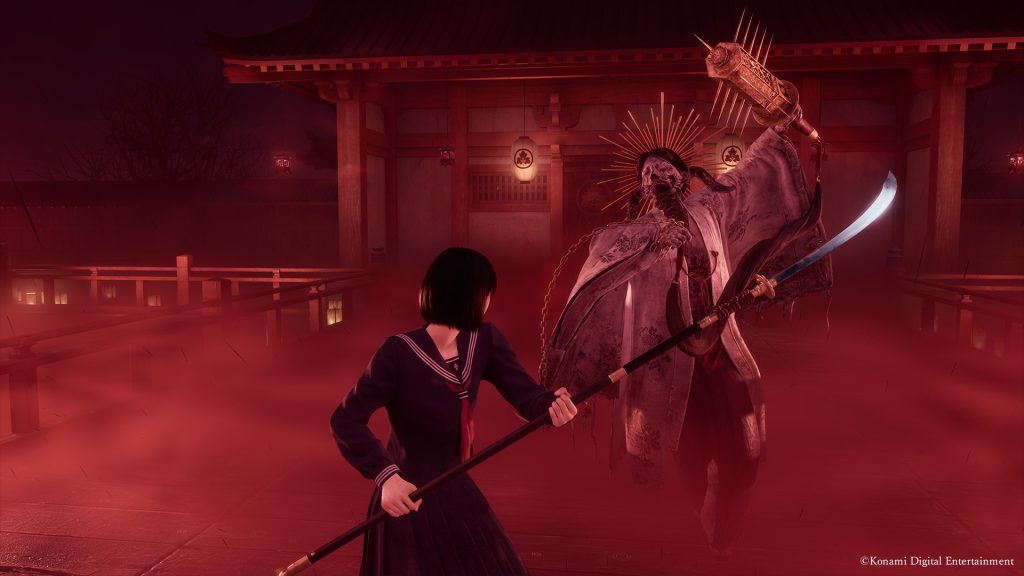In case you missed it, Silent Hill f is a pretty significant success, with over one million global shipments and digital downloads. It probably doesn’t seem like a big deal at first, but Konami also confirmed that it achieved this within a day, and that it’s moving units at a faster rate than Silent Hill 2 remake (which took less than a week but still).
When you consider that the publisher’s other big release of the year, Metal Gear Solid Delta: Snake Eater, sold over one million units in its first day, the true significance of Silent Hill f’s success becomes clearer. After all, Delta: Snake Eater was handled mostly by Konami (with assistance from Virtuos) and not only had the benefit of years of rumors and hype, but also being based on one of the greatest games of all time.
By comparison, Silent Hill f is a lot more experimental. It bears the Silent Hill name like an omen, but this is an original story with no direct connections to previous titles. The fictional setting of Ebisugaoka is rooted in 1960s Japan, marking the first time that a mainline Silent Hill has really transitioned away from the legendary town.
Then you have the developer, NeoBards Entertainment. You know, the studio behind such quote-unquote multiplayer hits as Resident Evil Re:Verse and Resident Evil Resistance, both panned and shut down relatively quickly. Trying to create a rudimentary multiplayer mode that isn’t Outbreak for Resident Evil of all things is no easy task, and they did work on the much better-received Mega Man Battle Network Legacy Collection, so credit where it’s due.
The point is that they were relatively untested in leading such a project. Even Bloober Team had some experience in the horror genre, quality of output notwithstanding. Then it was revealed that there would be – gasp – Soulslike elements such as a stamina bar, melee combat, and stat upgrades. Unforgivable, truly, even when the developer came out and clarified that these aren’t exclusively Soulslike elements.
Then the reviews started trickling in, and a large number of critics actually praised it. An 86 on Metacritic, based on 84 reviews at this time, is pretty good. On SteamDB, it peaked at 22,621 concurrent players shortly after launch, which is all the more impressive considering Silent Hill 2 remake hit 23,676 in its lifetime. Naturally, there are the qualms against performance, resulting in a “Mostly Positive” rating (though it’s currently not overwhelming), and the combat isn’t for everyone (which even applies to the critics).
And yet, Silent Hill f has made a pretty impressive impact, becoming one of the higher-rated titles in the franchise and standing out in a year that’s full of incredible releases. The real question is: Why?
Even if it didn’t receive the same level of marketing as Silent Hill 2 remake or Metal Gear Solid Delta: Snake Eater, it still benefited from the positive momentum of the former. You could call it a testament to the popularity of the Silent Hill franchise, despite years of dormancy, but newcomers can dive into the remake without much knowledge of the franchise. The fact that NeoBards opted for a brand new story made its title even more compelling for new players, especially those who enjoyed the remake.

As for the hardcore, Silent Hill f showcases that Konami is willing to go outside of its comfort zone and explore new horror-filled horizons. I’m not referring simply to the combat, but more so to bringing in the likes of Ryukishi07 to pen the narrative and kera to create the monsters. And though Akira Yamaoka is on board as composer, there are several other lesser-known names to the franchise, like Kensuke Inage, dai and xaki (though the latter two have worked with Ryukishi07 on Higurashi and Umineko).
The result is a Silent Hill that looks and sounds so unique while still channeling everything that makes the franchise so unnerving. The monstrosities contained within Ebisugaoka and the Otherworld are unlike anything seen in horror in general. One of many reasons why kera’s work is so well-regarded is that it dances between grotesque, beautiful, and downright ambiguous. You can’t help but admire the stellar designs while trying to keep your mind from wandering into their deeper, more disturbing nuances.
Ryukishi07 also has more than his fair share of fans – Higurashi no Noko Koro Ni, both the visual novel and anime, are pretty well known worldwide, and Umineko is considered one of his finest works. Perhaps the most hyped part about Silent Hill f’s announcement is confirmation of his involvement. I wouldn’t be surprised if curiosity played a huge part in the interest, if only to see what messed-up new tale he has to offer (and it is indeed quite messed up).
I’ve spoken about how the overwhelming theme of powerlessness and rebellion contributes to the survival horror, especially given protagonist Hinako’s situation. That oppressive feeling never really goes away, whether it’s because of the music or the overall direction of the narrative. There’s also a distinct fear of the unknown, and that even when we learn more about what’s really going on – Ebisugaoka’s secrets, Fox Mask’s role, and so on – it only drags us deeper into the abyss. The tagline “beauty in terror, terror from beauty” applies perfectly, considering what Hinako goes through, and it’s something that the writing, art direction, and music reinforce throughout.
I’m also a big fan of how the gore is handled in some scenes. Silent Hill f could very well show everything – and there’s still quite a bit of disturbing material to witness first-hand – but many places show surprising restraint. Instead, you hear it; you see Hinako’s body language. The implication of what’s really happening creates a much more terrifying picture in your mind – an old trick, but one that still works.
When you look back on the history of big-name Japanese psychological horror franchises, the number of games with follow-ups is surprisingly low. Siren remains dormant, with Sony renewing the IP every so often to celebrate its anniversary. Fatal Frame has received remasters, and will finally delve into remake territory with next year’s Fatal Frame 2: Crimson Butterfly. While Resident Evil continues to see success, its latest offerings have been more action-focused (though Village packed more than a few psychological frights).
It’s rather telling that some of the more recently notable psychological horror games out of Japan have been Chilla’s Art titles (The Bathhouse and The Closing Shift) and Kotake Create’s Exit 8 and Platform 8. Japanese horror is a genre which has been rather hit or miss since its boom period, defined by the likes of Ringu and Ju-on. Nevertheless, the fascination with Japanese folklore and spirits alongside the utter helplessness in the face of overwhelming supernatural elements that are never fully understood is one that’s as relevant as ever. Maybe not on the same level of popularity as the good old days, but still.
Silent Hill f feels like a throwback to the heyday of Japanese horror – of delving into that unknown, downright terrified but unable to look away – even if its gameplay is more contemporary by comparison. As much as Konami wants to experiment with the franchise in other new ways with future titles, what it and NeoBards have created is something that we desperately need more of in the triple-A space. If nothing else, this reinforces that the publisher should never have left it to begin.
Note: The views expressed in this article are those of the author and do not necessarily represent the views of, and should not be attributed to, GamingBolt as an organization.





Appreciate this post—concise and informative.
Thanks for your feedback! Silent Hill f’s return to the franchise seems to have struck a chord with both longtime fans and newcomers, which is impressive. The combination of fresh storytelling and familiar elements really seems to resonate with the audience.